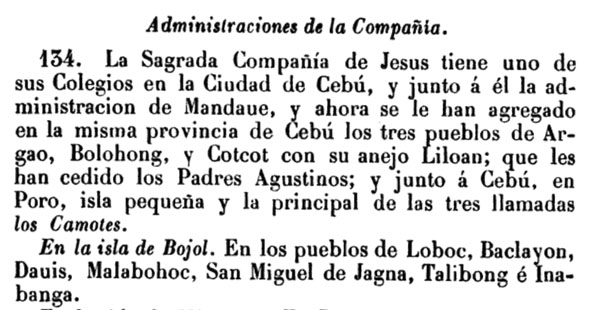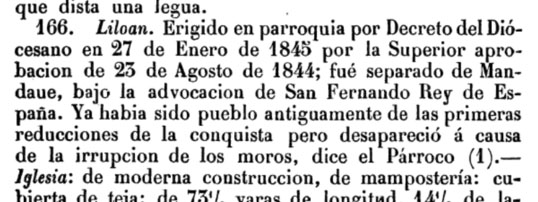
The term "Historic Mandaue" as used in these pages refers to the Municipality of Mandaue as it existed around 1800. At that time Mandaue consisted of today's City of Mandaue and Municipalities of Consolacion and Liloan. Thus Historical Mandaue was bounded by the Subangdaku River on the South, the Cotcot river on the North, Talamban on the West and Upon Channel on the East.
When these boundaries were established and how they changed over time is not known, except in a few cases. The outline below describes the main events which affected the boundaries of Mandaue.
1638 Mandaue:
The Diocese of Cebu, on their web site, lists 1638 as the founding of St. Joseph's parish in Mandaue. Since during the early Spanish period, priests and soldiers were the only Spaniards allowed to live outside Cebu City17, the local priest was typically the de facto representative the government. As a result, founding a parish was generally accompanied by the founding its municipality. Thus the founding of Mandaue is generally given as 1638. At this early period, the boundaries of Mandaue are unclear, as no documentation exists on when boundaries were established. The present boundaries were certainly in place by the early 1700's, by which time Mabolo on the South and Danao on the North were organized towns.
Additional evidence on the early boundaries of Mandaue is provided in the "Breve Reseña de lo que fue y de lo que es la Diócesis de Cebu en las Isla Filipinas" by Felipe Redondo y Sendino, 188658. This work gives a "Brief Review" of past and present of the Dioceses of Cebu. The entries below describes early events pertaining to Mandaue:

| Administration of the Society |
|
134. The Sacred Society of Jesus has one of its schools in Cebu City, and joined to it the administration of Mandaue,
and now have been added in the same province of Cebu the three villages of Argao, Bolohong and Cotcot with its annexed Liloan: that have been
given them by the Augustinian Fathers: and included in Cebu, Poro, a small island and the three called Los Camotes. On the island of Bohol. in the villages of Loboc, Baclayon, Dauis, Malabohoc, San Meguel de Jagna, Talibong and Inabanga. |
Cotcot, mentioned in the "Breve Reseña, was located along Cotcot river, which is now the northern border of Liloan. This location is clear from the phrase "with its annexed Liloan". The entry indicates that the Jesuits administered territory from Mandaue up to, and perhaps farther than the Cotcot river. Thus, it is reasonable to assume this area became part of Mandaue, when the town was formed. (For details on the disappearence and resettlement of the village of Liloan, see below.
1742 Danao:
According to the Dioceses of Cebu, the Parish Church of Danao was founded in 1742, from Danao. No information is included in the Breve Reseña regrading the boundaries of the original parish of Danao. However, considering Spanish practices, it is reasonable to assume that the town of Danao was also founded that year. As a result, it is likely the Cotcot river was established a the border between Mandaue and Danao in 1742, or shortly thereafter.
1845 Liloan:
As indicated in the "Breve Reseña" shown above, the village of Liloan existed at the time of the Spanish conquest. However, it was later abandoned due to the Moro raids. After the Moro raids were suppressed, Liloan was re-settled under the municipalitiy of Mandaue. This is confirmed by a December 1843 entry in the Protocolos35, which refers to Liloan as a "visita" attached to Mandaue, i.e. a mission visited by priests from St. Joseph's.

| 166. Liloan. Erected as a parish by Decree of the Dioceses on January 27, 1845, by approval of higher Authority on August 23, 1844; it was separated from Mandaue, under the patronage of San Fernando Rey de España. Formerly it had already been a village of the initial conquest but it was abandoned because of the raids of the Moros, according to the Pattovo (1). |
From this entry, we know the parish was founded January 27, 1845, however the date for the founding of Liloan is not as clear. A "Protocolos" entry of January 16, 1845, which uses the name "nuevo pueblo de Liloan", is a petition for approval of the boundary between Liloan and Mandaue59. This may indicate the town was founded earlier in January, or it may indicate the foundation process was under way but not yet complete. Another entry in the "Protocolos" on January 25, 1945, is particularly helpful, since it records the boundary agreed upon by Mandaue and Liloan34 . That boundary follows the Pitogo River, which today is located in the municipality Consolacion. This last date suggests that the Church and the town were essentially founded at the same time.
1871 Consolacion:
The Municipality of Consolacion was founded in 1871. The entry for Consolacion in the "Breve Reseña" gives the following information:

| 165. Consolacion. Erected as a parish by Decree of the Dioceses on February 21, 1871, with dedication to Saint Narciso, by approval of higher Authority on June 25, 1869, containing barrios of Mandaue, and of Liloan — |
Then in 1902 and 1903, Consolacion was unable to maintain its status as an separate town and reverted to Mandaue. In 1920, Consolacion was again made an independent municipality.